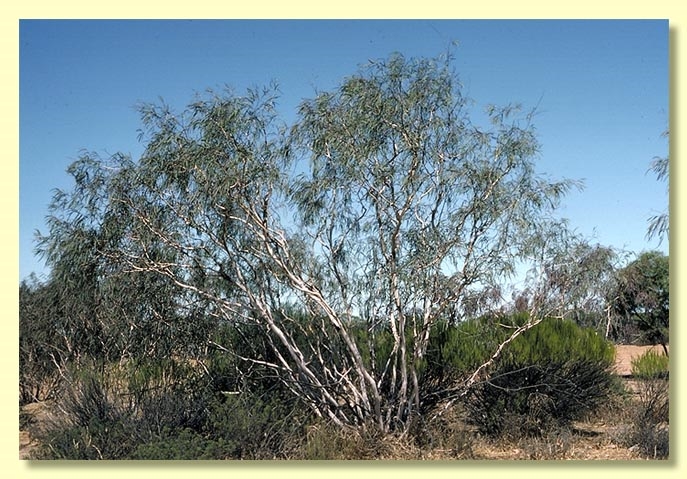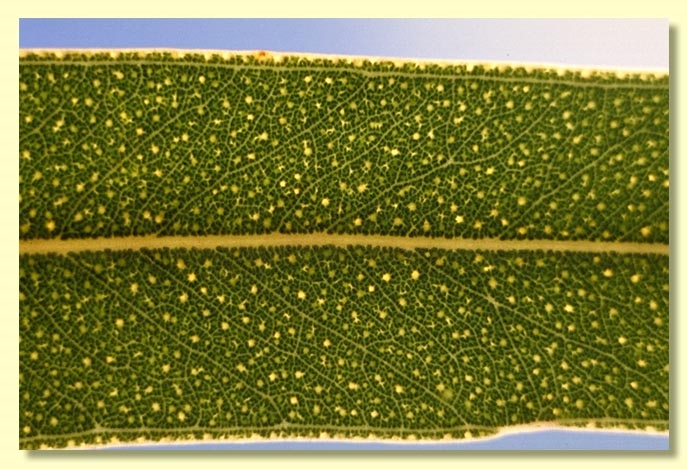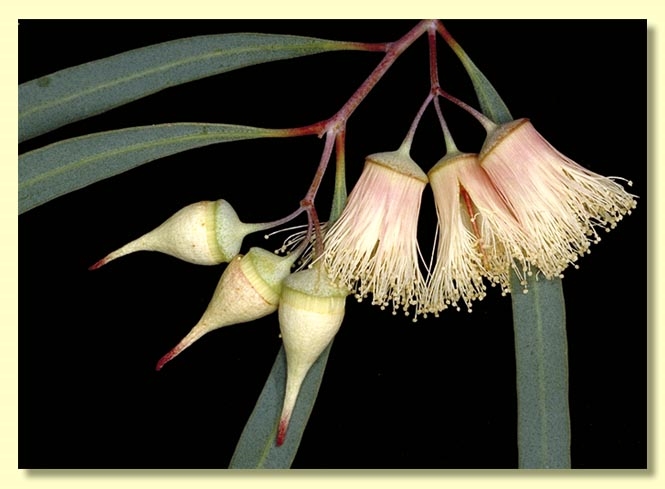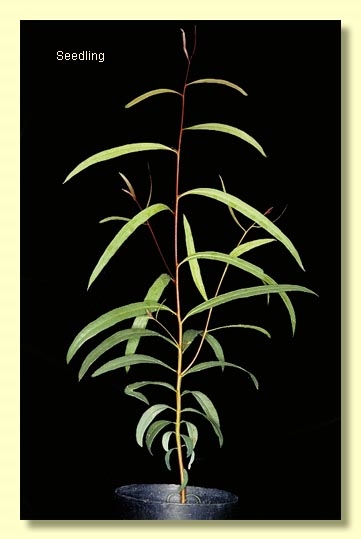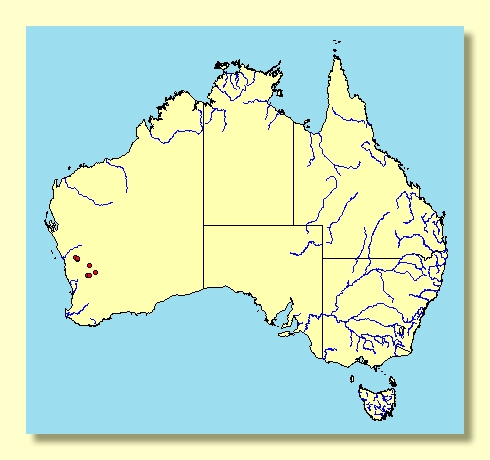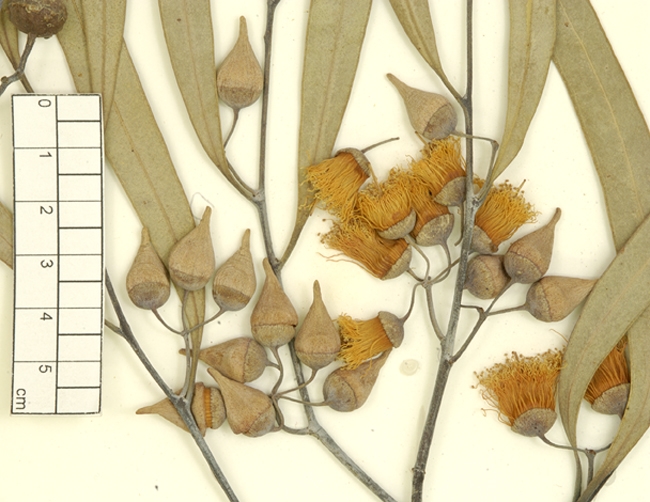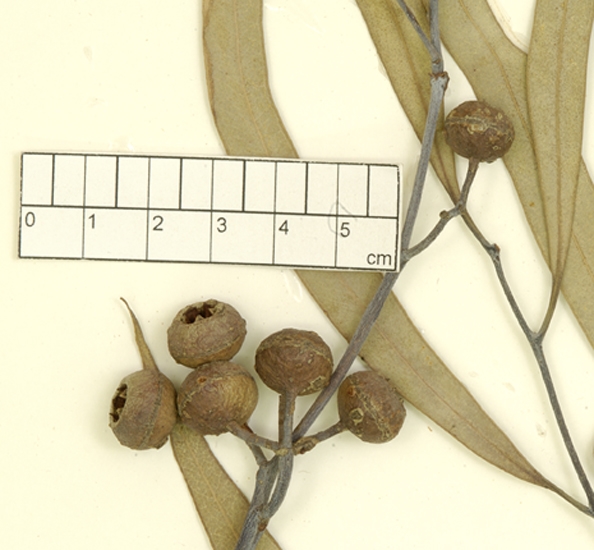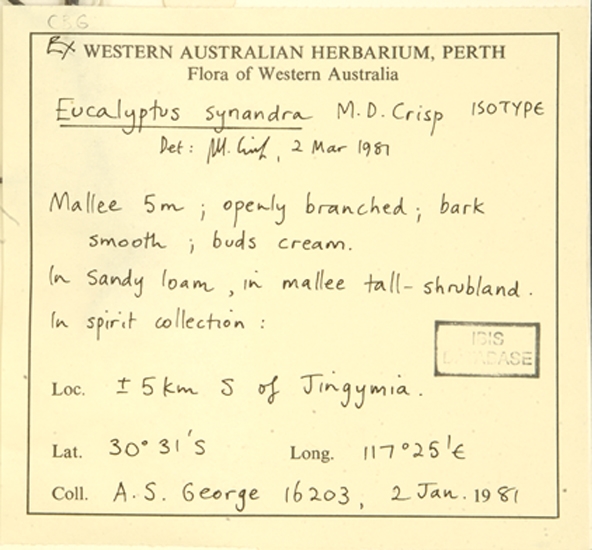Eucalyptus | Symphyomyrtus | Bisectae | Destitutae | Curviptera | Synandrae
Euclid - Online edition
Eucalyptus synandra
Bark smooth throughout, white, reddish and pale grey, sometimes powdery.
Branchlets often glaucous; lacking oil glands in the pith.
Juvenile growth (coppice or field seedlings to 50 cm): stems rounded in cross-section, warty or smooth, glaucous or not; juvenile leaves shortly petiolate, alternate, 5.5–9 cm long, 0.5–1.5 cm wide, dull, grey-green.
Adult leaves alternate, petioles 0.3–1.7 cm long; blade linear to narrowly lanceolate, sometimes falcate, 10–17(20) cm long, 0.5–1(1.5) cm wide, base tapering to petiole, margin entire, apex pointed, concolorous, green to blue-green, dull, side-veins usually greater than 45° to midrib, reticulation dense, intramarginal vein close to margin, oil glands intersectional.
Inflorescence axillary unbranched, pendulous, peduncles slender, 1–2.5 cm long, buds 7, pedicellate, pedicels (0.8)1–1.5 cm long. Mature buds ovoid (1.1–2.1 cm long, 0.6–0.8 cm wide), sometimes glaucous, scar present, operculum slenderly beaked and slightly narrower than the hypanthium at the join (0.9–1.6 cm long), stamens connate into a tube for about half their length, a few outer filaments erect, most inflexed to varying degrees, anthers oblong, versatile, dorsifixed, dehiscing by longitudinal slits, style long and straight, stigma blunt to tapered, locules 5, 6 or 7, the placentae each with 4 vertical rows of ovules. Flowers white or pink.
Fruit pedicellate, pedicels (0.8)1–1.5 cm long, shallowly hemispherical-obconical to almost saucer-like, 0.4–0.6 cm long, 0.9–1.3 cm wide, disc steeply ascending, oblique, valves 5, 6 or 7, at rim level or exserted.
Seeds brown, 1–2 mm long, angularly ovoid, scarcely ridged ventrally, dorsal surface shallowly reticulate, hilum ventral or more or less terminal.
Cultivated seedlings (measured at node 10): cotyledons Y-shaped (bisected); stems rounded in cross-section, warty or smooth; leaves subsessile to shortly petiolate, opposite for 6 to 8(12) nodes then alternate, linear and curved, 5.5–11.5 cm long, 0.5–1 cm wide, green.
Flowering has been recorded in January, February and December.
A mallee endemic to Western Australia, found in the northern wheatbelt, from Morawa to near Koorda and east to Karroun Hill north-east of Beacon. The stems are smooth, powdery and notably slender and the adult leaves conspicuously long and narrow, dull, light green.
Eucalyptus synandra belongs in Eucalyptus subgenus Symphyomyrtus section Bisectae subsection Destitutae because buds have two opercula, cotyledons are Y-shaped and branchlets lack oil glands in the pith. Within this subsection E. synandra is in series Curviptera, one of about 30 closely related species and subspecies further characterised by having large buds in umbels of one, three or seven, staminal filaments erect or oblique (rarely inflexed) in bud, and large fruit usually with an ascending disc and exserted valves.
Within series Curviptera this species has only two close relatives, E. beardiana and E. rosacea, all with an unusual feature that occurs nowhere else in the genus Eucalyptus — the stamens are united basally into a short tube. E. synandra is distinguished by its powdery bark, white to pink flowers and fruit with steeply ascending disk. E. beardiana is found only south of Shark Bay to the Murchison River, has non-powdery bark, yellow flowers and fruit with an almost flat disc. E. rosacea is a desert species from east of Laverton and Queen Victoria Springs with non-powdery bark, cream to pink or red flowers and fruit with a moderately ascending disc.
Both Eucalyptus synandra and E. rosacea are difficult to tell from E. leptopoda except when in flower, being similar in habit, leaf and fruit features. The creamy white stamens of E. leptopoda are never basally united into a tube.
Eucalyptus synandra is listed as "Vulnerable" under the Australian Government Environment Protection and Biodiversity Conservation Act 1999 (EPBC Act). Further information may be found at this web address:
http://www.environment.gov.au/cgi-bin/sprat/public/sprat.pl

